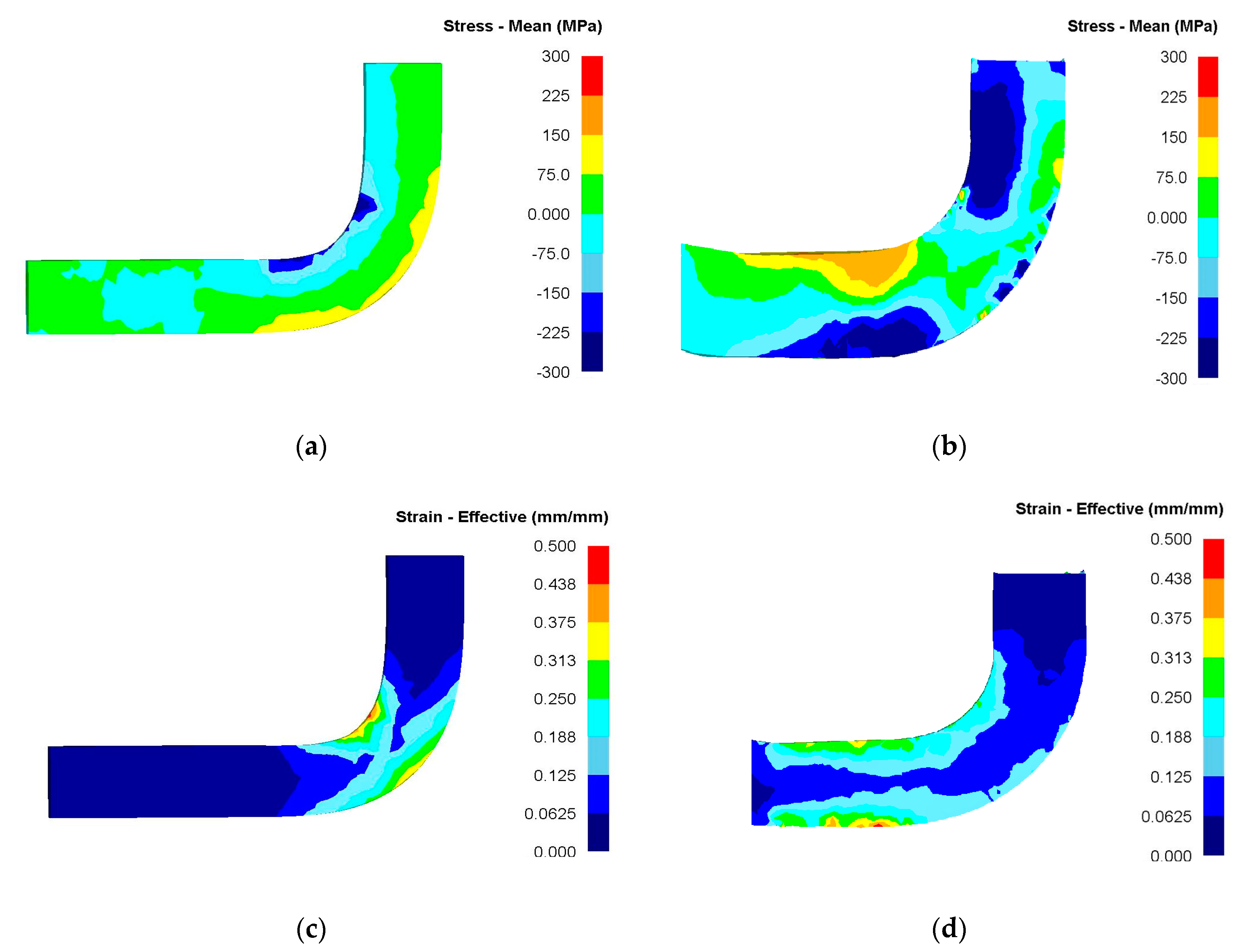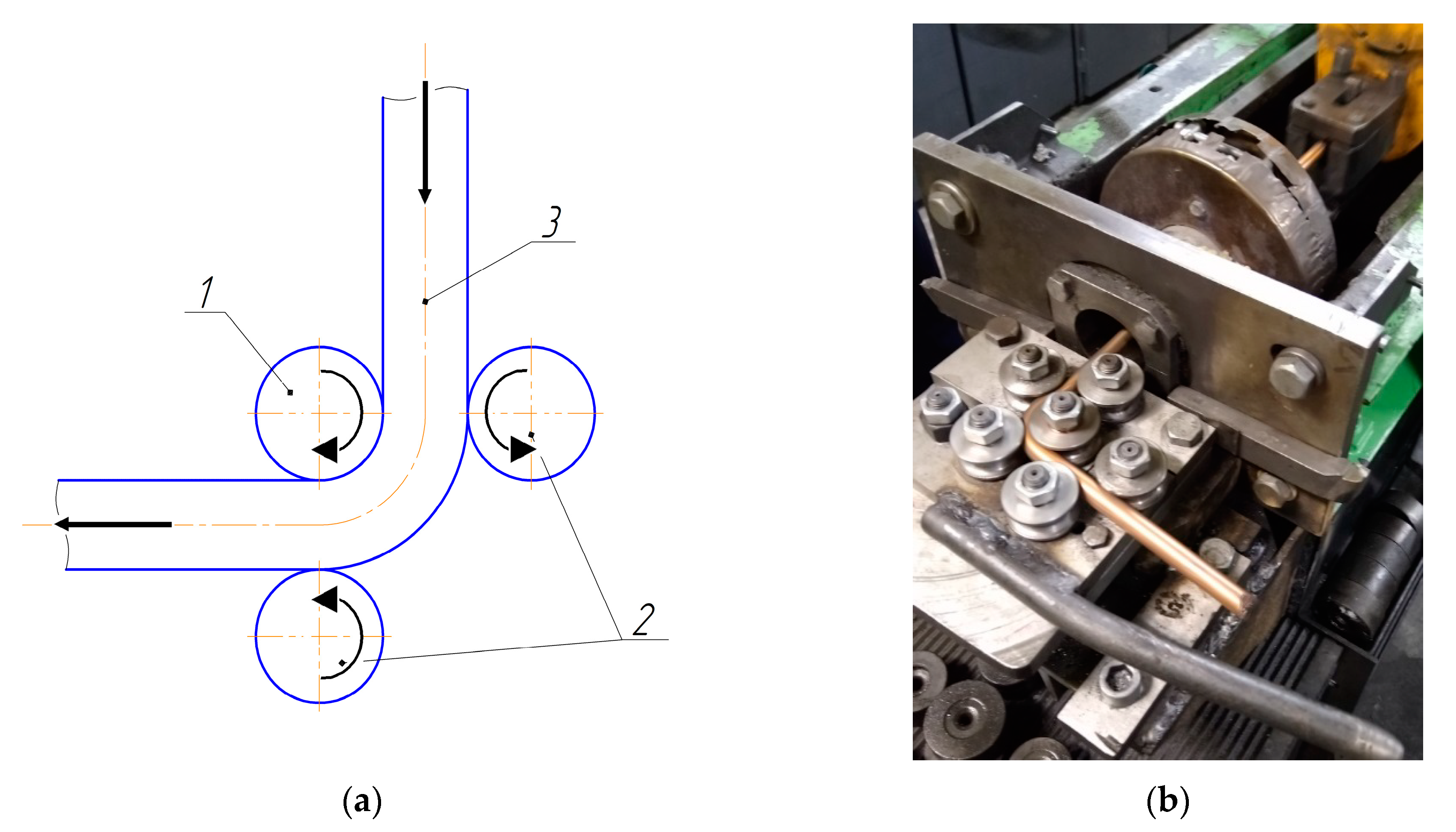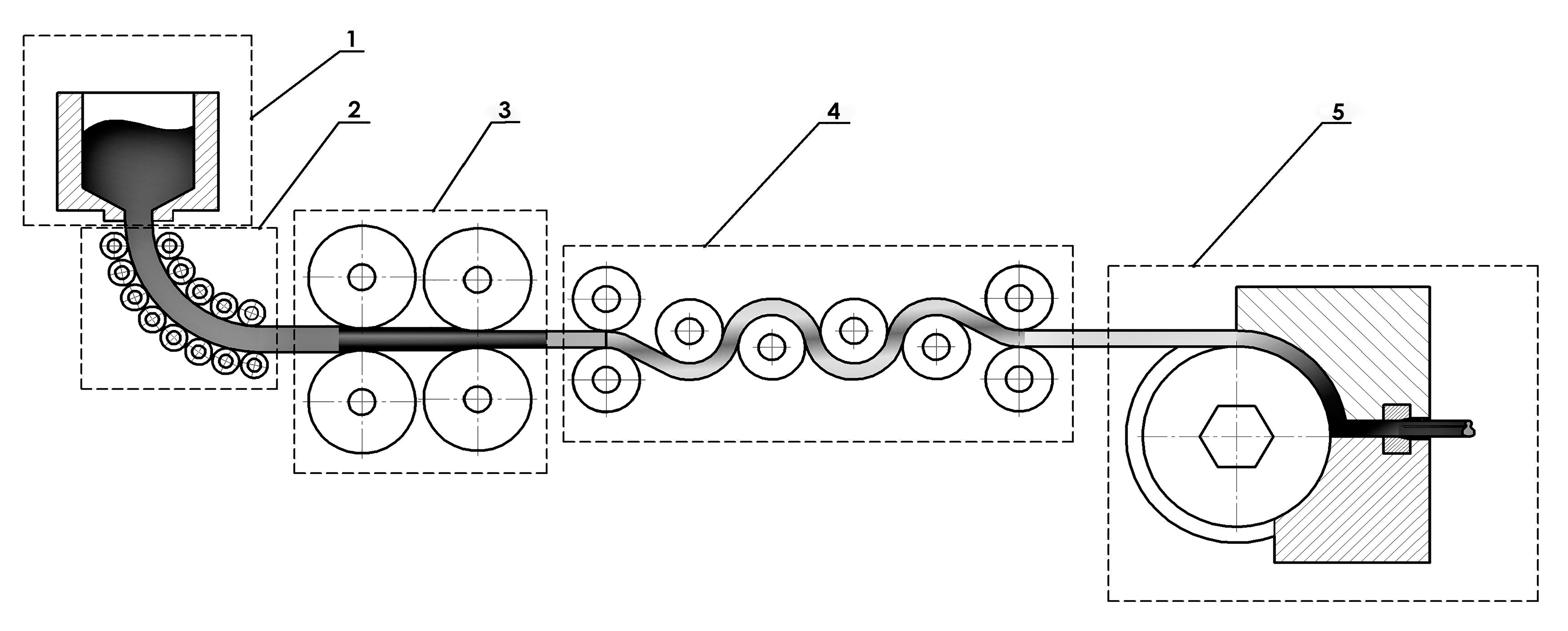Physical and Technical Foundations of the Use of Alternating Free Bending for Producing Long-length Semi-products from Metals and Alloys with Improved Mechanical Properties
Abstract
1. Introduction
2. Materials and Methods
3. Results
3.1. Stress–Strain State
3.2. Physical Experiment
4. Discussion
5. Conclusions
- The theoretical analysis of the effect that the character of the plastic deformation of metallic materials has on the efficiency of structure improvement demonstrates that the non-monotonic strain promotes a more intensive and, correspondingly, energy efficient refinement of the initial structure during deformation.
- A regularity is reveal suggesting that, unlike stationary bending, the process of the continuous bending of samples in movable rollers is accompanied by a continuous alternation of compressive and tensile stresses in the deformation site with interfaces along the midline and along the bisector of the bend angle.
- The deformation by bending results in a considerable strengthening of the Cu–0.5Cr alloy in the solid-solution state already after the first processing cycle. After four bending cycles, its strength increases almost 1.5-fold, with the cross section of the samples decreasing by maximum 10%.
- After four cycles of processing by continuous alternating free bending in rollers, a gradient-type structure is formed with finer fragments up 2 μm in the peripheral regions and coarser ones up to 9 μm in the central region. Correspondingly, the billets in the peripheral regions also have higher strength properties, in particular, their microhardness is 1.4 times higher than that in the central region.
- The obtained results can serve as the scientific and technical foundation for designing combined, highly adaptable to manufacture methods of the deformation of axis-symmetrical long-length objects from copper heat-hardenable alloys in the form of wire and shaped products, with a view to improve their performance properties.
Author Contributions
Funding
Acknowledgments
Conflicts of Interest
References
- Bridgman, P.W. Studies in Large Plastic Flow and Fracture; Foreign Languages Publishing House: Moscow, Russia, 1955; 444p. (In Russian) [Google Scholar]
- Rybin, V.V. Large Plastic Strains and Fracture of Metals; Metallurgiya: Moscow, Russia, 1986; 224p. (In Russian) [Google Scholar]
- Smirnova, N.A.; Levit, V.I.; Pilyugin, V.P.; Kuznetsov, R.I.; Davydova, L.S.; Sazonova, V.A. Structure evolution of FCC single crystals under large plastic strains. Fiz. Met. Metalloved. 1986, 61, 1170–1177. (In Russian) [Google Scholar]
- Segal, V.M.; Reznikov, V.I.; Kopylov, V.I.; Pavlik, D.A.; Malyshev, V.F. Processes of Plastic Structure Formation in Metals; Nauka i Tekhnika: Minsk, Belarus, 1994; 232p. (In Russian) [Google Scholar]
- Valiev, R.Z.; Alexandrov, I.V. Nanostructured Materials Produced by Severe Plastic Deformation; Logos: Moscow, Russia, 2000; 272p. (In Russian) [Google Scholar]
- Zherebtsov, S.V.; Salishchev, G.A.; Galeyev, R.M. Formation of submicrocrystalline structure in titanium and its alloy under severe plastic deformation. Defect Diffus. Forum 2002, 208–209, 237–240. [Google Scholar] [CrossRef]
- Beygelzimer, Y.E.; Synkov, S.G.; Orlov, D.V. Twist extrusion. Forging and Stamping Production. Mater. Work. Press. 2004, 6, 15–22. (In Russian) [Google Scholar]
- Segal, V.M.; Beyerlein, I.J.; Tome, C.N.; Chuvil’deev, V.N.; Kopylov, V.I. Fundamentals and Engineering of Severe Plastic Deformation; Nova Science Publishers: New York, NY, USA, 2010; 542p. [Google Scholar]
- Utyashev, F.Z.; Raab, G.I. Deformation Methods for the Fabrication and Processing of Ultrafine-Grained and Nanostructured Materials; Gilem: Ufa, Russia, 2013; 376p. (In Russian) [Google Scholar]
- Glezer, A.M. On the nature of ultrahigh plastic (megaplastic) strain. Bull. Russian Acad. Sci. Phys. 2007, 71, 1722–1730. [Google Scholar] [CrossRef]
- Glezer, A.M.; Metlov, L.S. Physics of megaplastic (severe) deformation in solids. Phys. Solid State 2010, 52, 1161–1169. [Google Scholar] [CrossRef]
- Valiev, R.Z.; Zhilyaev, A.P.; Langdon, T.G. Bulk Nanostructured Materials: Fundamentals and Applications; John Wiley & Sons, Inc.: Hoboken, NJ, USA, 2014; 456p. [Google Scholar] [CrossRef]
- Lapovok, R.; Pougis, A.; Lemiale, V.; Orlov, D.; Toth, L.S.; Estrin, Y. Severe plastic deformation processes for thin samples. J. Mater. Sci. 2010, 45, 4554–4560. [Google Scholar] [CrossRef]
- Ito, Y.; Harai, Y.; Fujioka, T.; Edalati, K.; Horita, Z. Use of ring sample for high-pressure torsion and microstructural evolution with equivalent strain. Mater. Sci. Forum 2008, 584–586, 191–196. [Google Scholar] [CrossRef]
- Andrievskiy, R.A.; Glezer, A.M. Strength of nanostructures. Uspekhi Fiz. Nauk 2009, 179, 338–358. (In Russian) [Google Scholar] [CrossRef]
- Vasiliev, L.S.; Lomayev, I.L. On the possible mechanisms of nanostructures evolution during the severe plastic deformation of metals and alloys. Fiz. Met. Metalloved. 2006, 101, 417–424. (In Russian) [Google Scholar]
- Kaibyshev, O.A.; Utyashev, F.Z. Superplasticity, Structure Refinement and Processing of Hard-to-Deform Alloys; Nauka: Moscow, Russia, 2002; 438p. (In Russian) [Google Scholar]
- Kaibyshev, O.A.; Utyashev, F.Z. Superplastisity: Microstructural Refinement and Superplastic Roll Forming; Futureplast: Arlington, TX, USA, 2005; 386p. [Google Scholar]
- Utyashev, F.Z.; Valiev, R.Z.; Raab, G.I.; Galimov, A.K. Strain accumulated during equal-channel angular pressing and its components. Russian Metall. (Metally) 2019, 4, 281–288. [Google Scholar] [CrossRef]
- Utyashev, F.Z.; Raab, G.I. The model of structure refinement in metals at large deformations and factors effecting grain sizes. Rev. Adv. Mater. Sci. 2006, 11, 137–151. [Google Scholar]
- Utyashev, F.Z.; Raab, G.I. The area of the surfaces of fragments, grains, and the sample upon large cold deformations of metals and the effect of these surfaces and the surface of the deformation zone on structure refinement. Phys. Met. Metallogr. 2006, 101, 285–295. [Google Scholar] [CrossRef]
- Utyashev, F.Z.; Raab, G.I. Effect of deformation site on structure refinement in metals. Fiz. Met. Metalloved. 2007, 104, 1–14. (In Russian) [Google Scholar]
- Utyashev, F.Z. Modern Methods of Severe Plastic Deformation; Ufa State Aviation Technical University: Ufa, Russia, 2008; 313p. (In Russian) [Google Scholar]
- Utyashev, F. Strain compatibility and nanostructuring of bulk metallic materials via severe plastic deformation. Mater. Sci. Forum 2011, 667–669, 45–49. [Google Scholar] [CrossRef]
- Asfandiyarov, R.N.; Raab, G.I.; Aksenov, D.A. Modeling of a combined process for the production of contact wires for high-speed railways. IOP Conf. Ser. Mater. Sci. Eng. 2018, 461, 012002. [Google Scholar] [CrossRef]
- Raab, A.G.; Aksenov, D.A.; Asfandiyarov, R.N.; Kodirov, I.S.; Raab, G.I. Development of severe plastic deformation methods for the production of contact wires from a Cu-Zr alloy for high-speed railways. IOP Conf. Ser. Mater. Sci. Eng. 2018, 447, 012088. [Google Scholar] [CrossRef]
- Ufa State Aviation Technical University. Device for Drawing and Production of Ultrafine-Grained Semi-Finished Products. Russian Federation Patent 2,347,632; IPC B 21 C 1/00, 12 November 2007.
- Raab, A.G.; Chukin, M.V.; Aleshin, G.N.; Raab, G.I. Investigation of a new shear deformation method for the production of nanostructures in low-carbon steel. IOP Conf. Ser. Mater. Sci. Eng. 2014, 63, 12008. [Google Scholar] [CrossRef]
- Loginov, Y.N. Copper and Deformable Copper Alloys; USTU-UPI Publ.: Ekaterinburg, Russia, 2006; 136p. (In Russian) [Google Scholar]
- Iwahashi, Y.; Furukawa, M.; Horita, Z.; Nemoto, M.; Langdon, T.G. Microstructural characteristics of ultrafine-grained aluminum produced using equal-channel angular pressing. Metall. Mater. Trans. A 1998, 29, 2245–2252. [Google Scholar] [CrossRef]
- Zherebtsov, S.V. Structural Transformations in the Process of Large Plastic Deformation and the Development of Methods for Producing an Ultrafine-Grained Structure in Semi-Products from Ti-Based Alloys. Ph.D. Thesis, Ural Federal University Named after the First Russian President B.N. Yeltsin, Ekaterinburg, Russia, 2013; 43p. (In Russian). [Google Scholar]
- Smirnov-Alyaev, G.A. Resistance of Materials to Plastic Deformation; Mashinostroenie: Leningrad, Russia, 1978; 368p. (In Russian) [Google Scholar]
- Raab, G.I.; Aksenov, D.A.; Asfandiyarov, R.N.; Raab, A.G.; Kodirov, I.S.; Janeček, M. Characteristics of the stress-strain state and structural changes in axisymmetric samples under sign-alternating deformation by free and constrained bending. Lett. Mater. 2019, 9, 494–498. [Google Scholar] [CrossRef]
- Asfandiyarov, R.N.; Aksenov, D.A.; Raab, G.I. Study of the processing of long-length billets by continuous free bending. IOP Conf. Ser. Mater. Sci. Eng. 2019, 672, 012018. [Google Scholar] [CrossRef]
- Lu, K. Making strong nanomaterials ductile with gradients. Science 2014, 345, 1455–1456. [Google Scholar] [CrossRef] [PubMed]









© 2020 by the authors. Licensee MDPI, Basel, Switzerland. This article is an open access article distributed under the terms and conditions of the Creative Commons Attribution (CC BY) license (http://creativecommons.org/licenses/by/4.0/).
Share and Cite
Raab, G.; Utyashev, F.; Asfandiyarov, R.; Raab, A.; Aksenov, D.; Kodirov, I.; Janeček, M.; Krajňák, T. Physical and Technical Foundations of the Use of Alternating Free Bending for Producing Long-length Semi-products from Metals and Alloys with Improved Mechanical Properties. Metals 2020, 10, 879. https://doi.org/10.3390/met10070879
Raab G, Utyashev F, Asfandiyarov R, Raab A, Aksenov D, Kodirov I, Janeček M, Krajňák T. Physical and Technical Foundations of the Use of Alternating Free Bending for Producing Long-length Semi-products from Metals and Alloys with Improved Mechanical Properties. Metals. 2020; 10(7):879. https://doi.org/10.3390/met10070879
Chicago/Turabian StyleRaab, Georgy, Farid Utyashev, Rashid Asfandiyarov, Arseniy Raab, Denis Aksenov, Ilyas Kodirov, Miloš Janeček, and Tomáš Krajňák. 2020. "Physical and Technical Foundations of the Use of Alternating Free Bending for Producing Long-length Semi-products from Metals and Alloys with Improved Mechanical Properties" Metals 10, no. 7: 879. https://doi.org/10.3390/met10070879
APA StyleRaab, G., Utyashev, F., Asfandiyarov, R., Raab, A., Aksenov, D., Kodirov, I., Janeček, M., & Krajňák, T. (2020). Physical and Technical Foundations of the Use of Alternating Free Bending for Producing Long-length Semi-products from Metals and Alloys with Improved Mechanical Properties. Metals, 10(7), 879. https://doi.org/10.3390/met10070879





